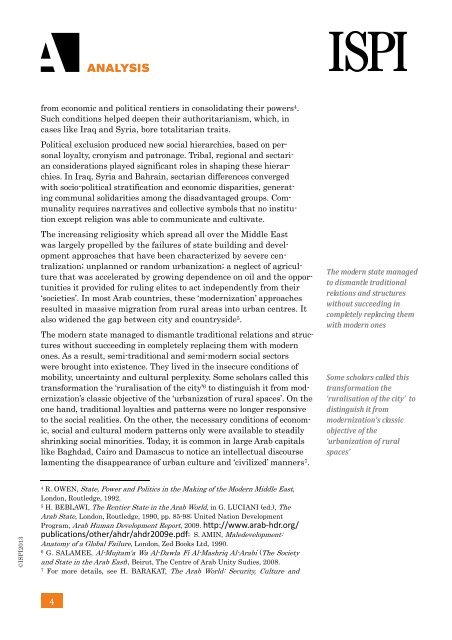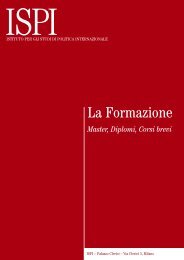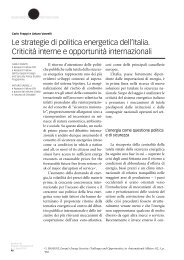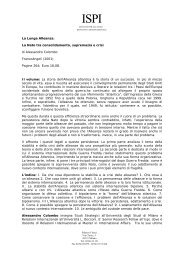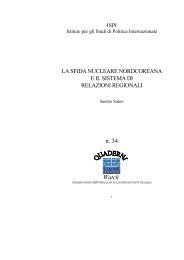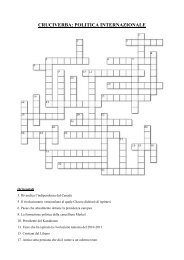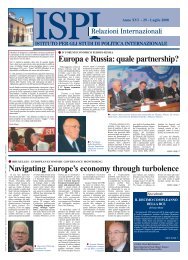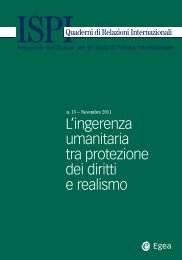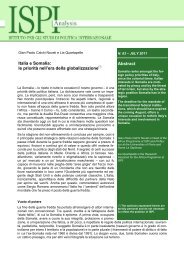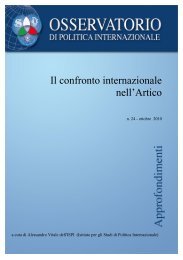heightened sectarianism in the middle east: causes, dynamics ... - Ispi
heightened sectarianism in the middle east: causes, dynamics ... - Ispi
heightened sectarianism in the middle east: causes, dynamics ... - Ispi
You also want an ePaper? Increase the reach of your titles
YUMPU automatically turns print PDFs into web optimized ePapers that Google loves.
from economic and political rentiers <strong>in</strong> consolidat<strong>in</strong>g <strong>the</strong>ir powers 4 .Such conditions helped deepen <strong>the</strong>ir authoritarianism, which, <strong>in</strong>cases like Iraq and Syria, bore totalitarian traits.Political exclusion produced new social hierarchies, based on personalloyalty, cronyism and patronage. Tribal, regional and sectarianconsiderations played significant roles <strong>in</strong> shap<strong>in</strong>g <strong>the</strong>se hierarchies.In Iraq, Syria and Bahra<strong>in</strong>, sectarian differences convergedwith socio-political stratification and economic disparities, generat<strong>in</strong>gcommunal solidarities among <strong>the</strong> disadvantaged groups. Communalityrequires narratives and collective symbols that no <strong>in</strong>stitutionexcept religion was able to communicate and cultivate.The <strong>in</strong>creas<strong>in</strong>g religiosity which spread all over <strong>the</strong> Middle Eastwas largely propelled by <strong>the</strong> failures of state build<strong>in</strong>g and developmentapproaches that have been characterized by severe centralization;unplanned or random urbanization; a neglect of agriculturethat was accelerated by grow<strong>in</strong>g dependence on oil and <strong>the</strong> opportunitiesit provided for rul<strong>in</strong>g elites to act <strong>in</strong>dependently from <strong>the</strong>ir‘societies’. In most Arab countries, <strong>the</strong>se ‘modernization’ approachesresulted <strong>in</strong> massive migration from rural areas <strong>in</strong>to urban centres. Italso widened <strong>the</strong> gap between city and countryside 5 .The modern state managed to dismantle traditional relations and structureswithout succeed<strong>in</strong>g <strong>in</strong> completely replac<strong>in</strong>g <strong>the</strong>m with modernones. As a result, semi-traditional and semi-modern social sectorswere brought <strong>in</strong>to existence. They lived <strong>in</strong> <strong>the</strong> <strong>in</strong>secure conditions ofmobility, uncerta<strong>in</strong>ty and cultural perplexity. Some scholars called thistransformation <strong>the</strong> ‘ruralisation of <strong>the</strong> city’ 6 to dist<strong>in</strong>guish it from modernization’sclassic objective of <strong>the</strong> ‘urbanization of rural spaces’. On <strong>the</strong>one hand, traditional loyalties and patterns were no longer responsiveto <strong>the</strong> social realities. On <strong>the</strong> o<strong>the</strong>r, <strong>the</strong> necessary conditions of economic,social and cultural modern patterns only were available to steadilyshr<strong>in</strong>k<strong>in</strong>g social m<strong>in</strong>orities. Today, it is common <strong>in</strong> large Arab capitalslike Baghdad, Cairo and Damascus to notice an <strong>in</strong>tellectual discourselament<strong>in</strong>g <strong>the</strong> disappearance of urban culture and ‘civilized’ manners 7 .The modern state managedto dismantle traditionalrelations and structureswithout succeed<strong>in</strong>g <strong>in</strong>completely replac<strong>in</strong>g <strong>the</strong>mwith modern onesSome scholars called thistransformation <strong>the</strong>‘ruralisation of <strong>the</strong> city’ todist<strong>in</strong>guish it frommodernization’s classicobjective of <strong>the</strong>‘urbanization of ruralspaces’©ISPI20134R. OWEN, State, Power and Politics <strong>in</strong> <strong>the</strong> Mak<strong>in</strong>g of <strong>the</strong> Modern Middle East,London, Routledge, 1992.5H. BEBLAWI, The Rentier State <strong>in</strong> <strong>the</strong> Arab World, <strong>in</strong> G. LUCIANI (ed.), TheArab State, London, Routledge, 1990, pp. 85-98; United Nation DevelopmentProgram, Arab Human Development Report, 2009. http://www.arab‐hdr.org/publications/o<strong>the</strong>r/ahdr/ahdr2009e.pdf; S. AMIN, Maledevelopment:Anatomy of a Global Failure, London, Zed Books Ltd, 1990.6G. SALAMEE, Al-Mujtam'a Wa Al-Dawla Fi Al-Mashriq Al-Arabi (The Societyand State <strong>in</strong> <strong>the</strong> Arab East), Beirut, The Centre of Arab Unity Sudies, 2008.7For more details, see H. BARAKAT, The Arab World: Security, Culture and4


